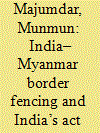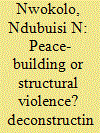|
|
|
Sort Order |
|
|
|
Items / Page
|
|
|
|
|
|
|
| Srl | Item |
| 1 |
ID:
080635


|
|
|
|
|
| Publication |
2008.
|
| Summary/Abstract |
From the eighteenth century onwards, the state took increasing responsibility for controlling activities within its borders. Prior to this, however, the role of the state was less clearly defined. In the early modern period, with Europe dominated by expansionist Empires comprised of loose collaborations of national groupings, state borders were often not clearly defined, and inadequately policed or protected by the central state. Thus, as well as the persistent threat of large-scale military invasion, frontier or borderland regions also became hotspots for cross-border banditry, smuggling and piracy, often on a well-established and semi-professional scale. As a result, border communities were often co-opted by the state to act as 'border guards', by policing and defending the state frontiers, in return for certain 'privileges', despite the fact that, in some instances, these border communities were known to participate in large-scale criminal activities themselves. By considering and comparing three separate border communities: the Cossacks of Southern Russia (fifteenth to eighteenth centuries), the Uskoks of Dalmatia (sixteenth and seventeenth centuries) and the Chods of Bohemia (twelfth to seventeenth centuries), and their involvement with large-scale cross-border criminal activities, this article will draw a number of general conclusions about the nature of crime in state border regions and the complicity of the state in many aspects of organised crime during the early modern period
|
|
|
|
|
|
|
|
|
|
|
|
|
|
|
|
| 2 |
ID:
173800


|
|
|
|
|
| Summary/Abstract |
The Manipur–Myanmar border is a fine example in establishing that cross-border linkages are far more central to historical change than previously acknowledged. Fencing of the Manipur–Myanmar border created barriers to economic exchanges and livelihood while dividing cultures and families. Therefore, understanding the ways in which the fencing affects the border communities is important and crucial for comprehending the role of the border communities living along the Manipur–Myanmar border in India’s Act East Policy (AEP), together with in examining the ways in which they can be engaged for the successful implementation of the policy.
|
|
|
|
|
|
|
|
|
|
|
|
|
|
|
|
| 3 |
ID:
172101


|
|
|
|
|
| Summary/Abstract |
There is a great conviction that the International Court of Justice’s ruling in 2002 on the Bakassi boundary dispute between Nigeria and Cameroon, and Nigeria’s decision to obey the ruling may have stopped a fierce inter-state war over the boundary. Indeed, many then ascribed to the whole boundary demarcation process as peacebuilding, disregarding the structural changes marked by the violence of forced migration. This article explores how the boundary delimitation has produced particular sorts of structural violence characterised by state neglect, loss of livelihoods and destitution. Thus, the article argues that although a full-blown war was avoided, the socio-economic conditions of the Nigerian populations on both sides of the border were not adequately considered and guaranteed as part of the peace-building agenda. It further argues that Nigeria, like many post-colonial states with the concentration of developments in major cities, neglects rural and border communities. Thus, the border communities accommodating the former Bakassi residents have further degenerated into ‘ill-governed’ spaces. This article uses structural violence as a framework to analyse the primary and secondary data to provide some deeper insights into the issues of violence being experienced by the local populations living on both sides of the demarcated border.
|
|
|
|
|
|
|
|
|
|
|
|
|
|
|
|
|
|
|
|
|